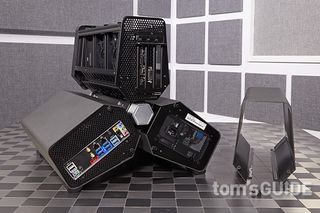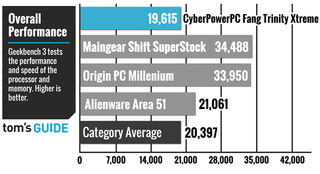CyberPowerPC Fang Trinity Xtreme Review: Good Things Come in Threes
The CyberPowerPC Fang Trinity Xtreme packs power and affordability into a showstopping chassis.
Why you can trust Tom's Guide

If you're looking for straight-up wow factor, the CyberPowerPC Fang Trinity Xtreme's cup runneth over. Housed in a three-sided chassis, the Fang (reviewed at $2,139, starting at $1,825) looks more like a piece on loan from the Museum of Modern Art than a gaming rig. But don't be fooled. Packed with a powerful Intel Core i7 processor and a 4K-resolution–capable Nvidia Titan X GPU, the Fang has more than enough bite to back up its bark.
Design
CyberPowerPC took the idea of what a PC desktop should look like and turned it on its head — thrice. Instead of the usual gargantuan rectangular tower, the company is using DeepCool's TriStellar gaming case, which separates the major components of a gaming desktop, splitting them up amongst three separate compartments (CPU, storage and performance) called blades.

The Performance blade resides at the top of the configuration, housing the GPU, while the left-bottom compartment, dubbed the Storage blade, can hold up to 3 SSDs, two mechanical hard drives and an optical drive if necessary. Last but not least is the CPU blade, where the processor resides with up to 16GB of RAM and compatibility for AMD or Intel mini ITX motherboards. The blade can also accommodate 120mm liquid cooling.
Each blade is covered in a matte-black aluminum sleeve that sort of resembles what you'd find on a heavy-duty barbecue grill. The covers can be easily slipped off once the screws holding them in place are removed. However, be sure to brace yourself once you slide one off, as each blade cover weighs a hefty 7.2 pounds.

The blades are bolted onto a hexagonal column accented by the big, black power button at the front with a red, backlit Gamer Storm logo. In its default position, the computer rests on the two bottom blades as evidenced by the thick rubber feet. However, I like balancing the contraption on a single blade; it just looks cooler.

A portion of the blades' front grilles is made from aluminum and painted a glossy black. The metal gives way to a shiny, black plastic core that wraps around a thick silver band. Around the back, you'll see three more painted aluminum covers protecting the desktop's interior.

All those metal parts add up fast. With all of its components in place, the Fang Trinity weighs a relatively light 47 pounds. It's not as likely to induce a hernia as, say, the Maingear Shift SuperStock (58.8 pounds), Alienware Area-51 or OriginPC Millennium (60 pounds each), but you'll still want to bend at the knees when moving the unit from place to place.
Ports and Expandability
The Fang Trinity has ports and jacks galore. On the front of the Performance blade, you'll find two USB 3.0 ports with jacks for a pair of headphones, a microphone and an optical input. There are several DisplayPorts located on the rear of the blade, along with DVI and an HDMI port.

You'll find the majority of your ports along the back CPU Blade, including four USB 3.0 ports, two USB 3.1 ports and a pair of USB 2.0 ports. The rear panel also houses an eSATA port, Ethernet, a Gigabit Ethernet port and jacks for audio-in, audio-out, rear speaker, c/sub and S/PDIF. The company also added a pair of Wi-Fi antennas in case you want to boost your signal. Rounding out the ports/switch selection is the power switch and plug that reside on the back of the Storage blade.

The ability to slide the protective covers off of the blades makes tinkering with the Fang Trinity's interior a piece of cake. Each blade is spacious enough to accommodate several extra components. For example, the Performance blade can house several hard drives in addition to your GPU. The Storage blade can hold up to three SSDs, two mechanical hard drives and an optical drive. Space for the cooling system is reserved in the CPU blade.
4K Gaming and Graphics
Unfortunately, the CyberPowerPC Fang Trinity isn't rocking three Nvidia GeForce Titan X GPUs like some of its competitors are. However, its single graphics card is more than powerful enough to play demanding titles such as Grand Theft Auto V. I went cruising down the San Andreas coastline, with the top down on my shiny red convertible, air blowing through my afro, at least until I arrived at my destination and started peeling off shots at a rival gang.

My shots connected cleanly, and I made quick work of most of the crew. I saved the leader for last, mowing him down with my car. The scene was a beautiful cacophony of violence that averaged 35 fps at 3840 x 2560 on very high settings. The frame rate jumped to 41 fps on high and 45 fps on medium.

The desktop's performance was less impressive on the Metro: Last Light benchmark, where the device delivered 102 fps on low at 4K, falling below the 116 fps category average. The Maingear Shift SuperStock and its trio of Nvidia Titan X cards in SLI configuration hit 125 fps. Laden with three Nvidia GeForce GTX 980 GPUs in SLI, the Alienware Area-51 and the OriginPC Millennium obtained scores of 105 fps and 84 fps, respectively.

When the settings were cranked to high, the Fang Trinity dropped to 19 fps, which is below the 9 fps category average. The Area-51, Shift and Millennium took hits as well, falling to 26, 24 and 16 fps, respectively
The Fang tore through the less graphically intensive BioShock Infinite, achieving 146 fps at 1080p on high. That wasn't enough, however, to beat the Shift or the Millennium, which posted scores of 237 and 201 fps, respectively. The Area-51 also edged out the Fang, at 185 fps.
Performance
Outfitted with a 3.3-GHz Intel Core i7-5820K processor with 16GB of RAM, the CyberPowerPC Fang Trinity can handle heavy-duty multitasking with aplomb. The gaming PC had no problem streaming an episode of Orange Is the New Black on Netflix while running Grand Theft Auto 5 with 11 open tabs in Internet Explorer, Mozilla Firefox and Google Chrome.
However, on the Geekbench 3 synthetic benchmark, the Fang notched only 19,615, failing to match the 20,397 desktop average. It was woefully outdone by the Maingear Shift SuperStock (3-GHz Intel Core i7-5960X CPU) and OriginPC Millennium (3.6-GHz Intel Core i7-5960X CPU), which delivered 34,488 and 33,950, respectively. The Alienware Area-51 and its 3.8-GHz Intel Core i7-5820K did only slightly better, at 21,060.

During our file-transfer test, the Fang's 250GB SSD, which comes with a 2TB 7,200-rpm hard drive, duplicated 4.97GB of mixed-media files in 35 seconds for a transfer rate of 145MBps, missing the 208.2MBps average. The Shift, with its pair of 250GB SSDs and its 3TB 7,200-rpm hard drive, delivered 346MBps, continuing its beastly dominance. The Millennium (1TB SSD and a 4TB hybrid hard drive)and Area-51 (256GB SSD with a 4TB, 6K-rpm hard drive) weren't too far behind, at 221MBps each.

On our spreadsheet test, the Fang paired up 20,000 names and addresses in 3 minutes and 44 seconds, which is slightly slower than the 3:29 average. However, that's fast enough to beat the Area-51's time of 3:50, but not those of the Shift or Millennium, which clocked 2:55 and 3:34, respectively
Configurations
I reviewed the Xtreme model of the CyberPowerPC Fang Trinity. Priced at $2,139, the gaming PC is cheap in comparison to the competition. For that amount, you get a 3.3-GHz Intel Core i7-5820K processor with 16GB of RAM, a 250GB SSD with a 2TB 7,200-rpm hard drive and an Nvidia GeForce Titan X GPU with 12GB of VRAM.
The base price of the Xtreme model is $1,825, which buys you a 3.3-GHz Intel Core i7-5820K CPU, 16GB of RAM, a 256GB SSD, a 2TB hard drive and an Nvidia GeForce 970 GPU with 4GB of VRAM.
The basic Trinity 100 model costs $985 and has a 3.4-GHz AMD A10-7700K CPU with Radeon R7 8GCN Cores Graphics, 8GB of RAM, a 128GB SSD with a 1TB hard drive and an Nvidia GeForce 750Ti with 2GB of VRAM.
Software and Warranty
Despite the Fang Trinity's outlandish proportions, it's surprisingly light on bloatware. In fact, you won't find any third-party apps; instead, you have the usual Windows 8.1 software (Mail, Calendar, OneNote and Skype).
The CyberPowerPC Fang Trinity comes with a 3-year limited warranty (3 years parts, 1 year labor) and lifetime technical support.
Bottom Line
Is it a piece of art or a gaming PC? The honest answer is that CyberPowerPC Fang Trinity Xtreme is a lot of both. You've got a visually striking design that's both breathtaking and functional, with guts that can dish out respectable frame rates when it's time to start serving n00bs. On top of all that, at $2,139, this gaming PC is relatively affordable compared to some of its more tricked-out brethren.
I would definitely recommend outfitting the Xtreme with a more powerful CPU and a few more SSDs to speed up performance. Still, the CyberPowerPC is a great choice for budget-conscious gamers who don't want to make too many compromises on performance.
Sign up to get the BEST of Tom’s Guide direct to your inbox.
Upgrade your life with a daily dose of the biggest tech news, lifestyle hacks and our curated analysis. Be the first to know about cutting-edge gadgets and the hottest deals.
Sherri L. Smith has been cranking out product reviews for Laptopmag.com since 2011. In that time, she's reviewed more than her share of laptops, tablets, smartphones and everything in between. The resident gamer and audio junkie, Sherri was previously a managing editor for Black Web 2.0 and contributed to BET.Com and Popgadget.

